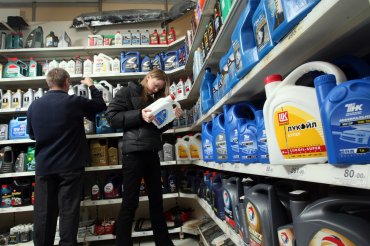MOSCOW – Russias consumption of engine oils for on-road vehicles stagnated in 2015, but vehicle usage rates are rising as is the proportion of oils that meet recent industry standards, according to Autostat, a Moscow-based analytical agency.
The nation consumed 417 million liters of on-road automotive engine oils in 2014, including 290 million liters installed in gasoline powered engines and 127 million liters in diesel engines, Victor Pushkarev, Autostats project manager, told Global Business Clubs CIS Base Oils and Lubricants conference held in Moscow in May.

Ilya Pitalev
Engine oils meeting recent specifications are becoming a larger portion of the Russian market.
Autostat generates its data by conducting online polls several times a year to profile the nations population of passenger cars, light commercial and heavy-duty vehicles. Once armed with a profile of the population, it uses information on oil volume, drain intervals and driving habits to extrapolate lubricant demand.
In 2015 the number of the countrys total fleet stayed the same as in 2014 – at around 41 million units, Pushkarev said. In 2015, the number of vehicles in active use has grown by 5.3 percent compared to the year before, while the fleet that uses the latest motor oil standards has grown by 11 percent. The main growth happened in the passenger car segment using the latest API [American Petroleum Institute] specifications.
Autostat found that in 2015, this has led to an increased demand for motor oils that conform to the latest API specifications. On the flip side, the commercial and heavy-duty vehicle segment was characterized by extended drain intervals and lower freight transport. The passenger car segment was affected by the slim economic activity of Russian motorists caused by the recession, Pushkarev observed.
In 2015, roughly 50 percent of the passenger car motor oils consumed in Russia were semi-synthetic blends, according to the agency. Forty five percent of the total motor oils consumed were mineral oils [primarily Group I base oil blends] the consultancy said, while the rest, or 5 percent share of the consumed oils, were full synthetics.
In 2015, the SAE grade structure of these motor oils was the following: 40 percent of PCMOs consumed in Russia were SAE 10W-40 grade, while 30 percent were 5W-30 and 10 percent were 5W-20 grade, according to Autostat. Twenty percent were other grades.
The consultancy made a geographical breakdown of the motor oil used in passenger car engines. It found that more than 76 percent of the motor oil volume was consumed in the European part of Russia, while the rest is consumed in the regions of Ural, Central Siberia and the Russian Far East.
For example, in 2014 the Central Federal District consumed 74 million liters of PCMOs, followed by the Volga Federal District, which used 47 million liters of PCMOs. The next large PCMO consuming region is the Siberian Federal District that consumed 25 million liters, followed by the Southern Federal District that consumed 22 million liters. The Northwestern and Ural federal districts consumed around 21 million liters of PCMOs each, while North Caucasian and Far East Federal Districts consumed 11 and 8 million liters, respectively.
In 2015 the foreign-branded car owners dominantly preferred the Mobil, Castrol and Shell brands. Mobil was a pick to 21 percent of the respondents polled by Autostat. Castrol was preferred by 17 percent of the respondents, while Shell was the choice of 12 percent of motorists. Less preferable foreign car brands were LiquiMoly (8 percent), Elf (6 percent), Motul (5 percent) and Total (3 percent).
On the other hand, Russian Lukoil was the most popular brand for drivers of traditional Russian car brands, such as Lada and Uaz, being preferred by 16 percent of individuals polled. Shell was preferred by 14 percent of motorists, Mobil and Castrol by 13 and 11 percent, respectively.
Autostat also found that from August 2014 to January 2016, the average price of foreign-branded motor oils increased by 115 Russian rubles (U.S. $1.80) per liter, while the prices for the motor oils made in Russia hiked on average by 20 rubles per liter.